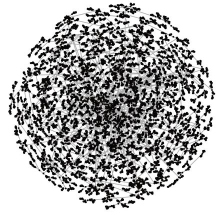Stochastic Model-Data Fusion on Networks: Disease Spread and Cascade Failure

The SNF funded research project “Stochastic Model-Data Fusion on Networks: Disease Spread and Cascade Failure” with the group of researchers Ramzi Dakhmouche and Noé Stauffer as PhD students, Hossein Gorji (Empa) as Principal Investigator, Ivan Lunati (Empa) and Jan Hesthaven (EPFL) as partners.
The project aims to develop novel methodologies to improve model predictions and guide intervention measures in response to increasing risks of disease spread and cascade failure. We address the modeling challenges posed by large networks and integrate ideas from machine learning and stochastic modeling to enable efficient yet highly accurate predictions of complex network dynamics. Machine learning methods have emerged as powerful tools with the potential to deal with the challenges of increasing complexity. However, purely data-driven approaches remain tied to problems for which huge data sets are accessible. In contrast, high-dimensional and dynamic networks often lack sufficiently large data sets to rely on a purely data science approach.
The model reduction techniques developed for real-world networks can play a crucial role in merging mechanistic and data-driven approaches by providing a sufficiently accurate yet computationally affordable description of complex phenomena. By pursuing a work plan for such model data fusion, we aim to develop data-driven reduced stochastic models. In addition to questions of scientific computing in areas of uncertainty quantification and the optimal design of stochastic networks, such techniques have overarching applications from the development of digital twins to human mobility modeling, and to fake news detection.

Model reduction
The goal of my research is to address the multiple issues arising in the study of high dimensional dynamical systems by developing a relevant model reduction framework, with a particular focus on network models. The enormous amount of variables involved in the ”microscopic description” of such systems hinders a direct integration of the set of governing equations. Moreover, uncertainty in the system’s parameters and initial state, partial observability as well as exogenous forcing naturally favor a statistical description. Motivated by this observation, I aim to build a generic model reduction technique drawn on ideas from the rich field of statistical physics, following projection operator techniques and moments-based approaches.


Symbolic regression

Most real-world networks of physical, social or biological interactions are prone to high dimensionality, measurement noise, uncertainty and intricate interplay between network topology and the underlying dynamic mechanisms. This makes deriving accurate models from first principles particularly challenging if not impossible. Hence, I work on devising robust and efficient methods to learn models and control policies directly from measurement data, leveraging tools from deep learning, Bayesian statistics, and reinforcement learning. As for applications, my work is specifically focused on electrical grid management, infectious disease forecasting and cellular drug response prediction.

